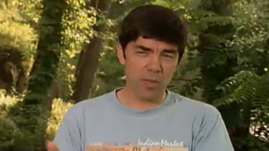Teachers' Domain - Digital Media for the Classroom and Professional Development
User: Preview



David Boxley of the Git-Hoan Dancers discusses dance traditions of the Tsimshian, whose descendants live on the Northwest coast of northern British Columbia and in southeastern Alaska. He discusses the use of masks and other handmade regalia in the dances.
This resource is part of the Native American Culture collection.
Find additional arts resources for your classroom at the KET Arts Toolkit website.
The Tsimshian people are from the Northwest Coast of northern British Columbia and southeastern Alaska. Most of the group’s members who live outside of the reservations trace their roots and heritage to the Tsimshian village of Metlakatla in southeast Alaska. Metlakatla is located on the Port Chester harbor, on Annette Island, about 15 miles south of Ketchikan. Metlakatla comes from maxlakxaala, a Tsimshian word meaning “salt water passage.” Git-Hoan means “people of the salmon,” alluding to the nation’s connection to the sea and its resources.
Archaeological excavations in the harbor at Prince Rupert, British Columbia, have unearthed the remains of cedar plankhouse villages that date back 5,000 years; thus, the Tsimshians claim one of the oldest continuous cultural heritages in the New World. Tsimshian groups are also generally held to be related historically to the Penutian peoples of Oregon and California. Like their neighbors, the Tlingit of Alaska and the Haida of Haida Gwaii, the Tsimshian represent the Northwest Coast cultural area, characterized by totem poles and potlatch feasts at which wealth is distributed. Potlatch ceremonial feasts are still given to punctuate name-giving, marriage, divorce, adoption, and funerals. Originally, descent was reckoned through the female line and each Tsimshian still recognizes him/herself as belonging to one of four tribes or totems: Frog or Raven, Wolf, Eagle, and Killer Whale or Fireweed.
Like the Eastern Band of Cherokee, the Tsimshian of the Annette Island Reserve in Alaska experienced long periods in their history when their traditional dances and ceremonies were repressed or outlawed. Like the Cherokee Warriors of AniKituhwa, the Git-Hoan Dancers have undertaken research from remaining materials such as film reels, recordings, and artifacts and have added their artistic intuition to recreate the traditional dances of their ancestors. David Boxley, leader of the Git-Hoan Dancers, explains, “We’re old, but we’re new…we’re doing what the old people used to do…bringing our stories to life.” Because so much of the traditional culture has been lost, the Git-Hoan Dancers also are mask makers and songwriters. Boxley and his son study the ancient masks of their people in museums and carve masks following their designs. They wrote all but three of the songs used in their performances.
 Loading Standards
Loading Standards